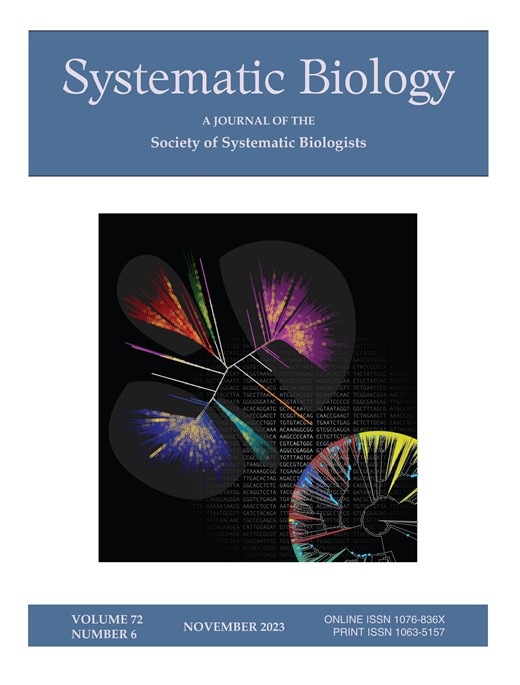Evolutionary rate incongruences in squamates reveal contrasting patterns of evolutionary novelties and innovation.
IF 5.7
1区 生物学
Q1 EVOLUTIONARY BIOLOGY
引用次数: 0
Abstract
Understanding the rate of phenotypic evolution can reveal fundamental aspects of organismal evolutionary trajectories. Hence, several studies have attempted to detect the tempo of evolution for multiple organisms, although based on different datatypes (e.g., discrete and morphometric) and methods (phylodynamic vs comparative methods). Here, we ask whether these competing approaches provide comparable estimates of rate trajectories using an expanded squamate phylogenetic dataset that is matched (to the species-level) with new geometric morphometric data, while also assessing method robustness to fossil sampling. Our new squamate total-evidence time-tree suggests a new placement for several putative stem pleurodontan iguanians (Temujinidae) as stem acrodontans, while matching divergence time estimates of recent phylogenomic studies. We show that low fossil sampling inadvertently removes entire regions of the morphospace and leads to contraction of crown clade phenotypic diversity, as morphospace boundaries are frequently delimited by transitional fossils. Critically, different datatypes produce incongruent rate patterns, which are further exacerbated by methodological differences. We suggest that phylogenetic discrete data (i.e., characters) are strongly influenced by neomorphisms and reveal phenotypic novelties, while morphometric data (i.e., shape) reflects changes in phenotypic refinement leading to phenotypic innovation. This conceptual distinction conciliates discrepant macroevolution trajectories across squamates, which we expect to be generalizable to other systems across the Tree of Life.鳞片的进化速率不一致揭示了进化新颖性和创新的对比模式。
了解表型进化的速率可以揭示生物体进化轨迹的基本方面。因此,一些研究试图检测多种生物的进化速度,尽管基于不同的数据类型(例如,离散和形态计量)和方法(系统动力学与比较方法)。在这里,我们询问这些相互竞争的方法是否使用扩展的鳞片系统发育数据集提供了可比较的速率轨迹估计,该数据集与新的几何形态测量数据相匹配(在物种水平上),同时还评估了方法对化石采样的稳健性。我们新的鳞状动物的总证据时间树表明,几种假定的茎棘齿鬣蜥(Temujinidae)作为茎尖齿动物的新位置,同时与最近系统基因组学研究的分化时间估计相匹配。我们表明,低化石采样无意中消除了形态空间的整个区域,并导致冠状枝表型多样性的收缩,因为形态空间边界经常被过渡化石所划定。关键的是,不同的数据类型产生不一致的比率模式,这进一步加剧了方法的差异。我们认为,系统发育离散数据(即性状)受到新形态的强烈影响,揭示了表型的新颖性,而形态计量数据(即形状)反映了导致表型创新的表型改进变化。这种概念上的区别调和了不同鳞片的宏观进化轨迹,我们期望它可以推广到生命之树的其他系统。
本文章由计算机程序翻译,如有差异,请以英文原文为准。
求助全文
约1分钟内获得全文
求助全文
来源期刊

Systematic Biology
生物-进化生物学
CiteScore
13.00
自引率
7.70%
发文量
70
审稿时长
6-12 weeks
期刊介绍:
Systematic Biology is the bimonthly journal of the Society of Systematic Biologists. Papers for the journal are original contributions to the theory, principles, and methods of systematics as well as phylogeny, evolution, morphology, biogeography, paleontology, genetics, and the classification of all living things. A Points of View section offers a forum for discussion, while book reviews and announcements of general interest are also featured.
 求助内容:
求助内容: 应助结果提醒方式:
应助结果提醒方式:


